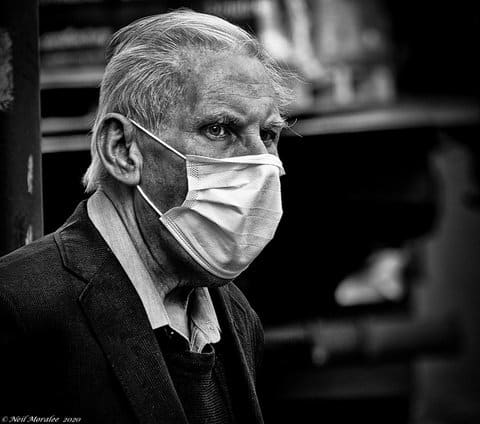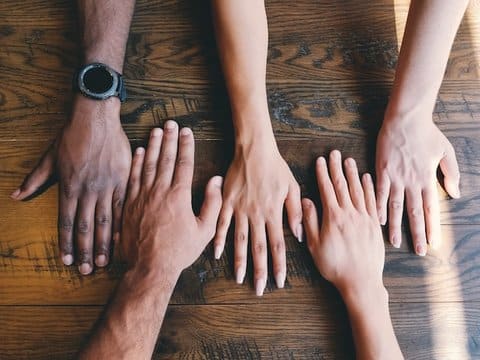
13 Jan Pandemic Hitting Older People Hardest, But Everyone Still at Risk

COVID has isolated older and disabled people throughout the pandemic. While they tend to face the greatest health dangers, they’re not the only ones at risk. (“Older Men at the Margins” by Neil Moralee on Flickr, used under CC BY-NC-ND 2.0 license)
By Danielle Parenteau-Decker
The pandemic has increasingly been portrayed as something only older and immunocompromised people need to worry about. But this characterization isolates those people and ignores the existing and very real dangers of COVID-19 to the general population.
Ethnic Media Services hosted a national news briefing Dec. 16 about COVID-19, looking in part at how the illness disproportionately affects older and disabled people as well as California’s efforts to help its eldest residents.
Viral infections — namely, COVID-19, flu and respiratory syncytial virus — have been on the rise recently among all ages.
“Our hospitals are packed,” said Dr. Tomás Aragón, director of the California Department of Public Health and state public health officer. Healthcare facilities are being inundated with respiratory illness cases and dealing with “delayed care” of other issues.
Overworked healthcare providers are also dealing with staffing shortages and the risk of getting sick themselves.
“These infections infect healthcare workers,” Aragón said. “They’re exhausted, they’re tired, and they’re sick.”
While anyone can become seriously ill or even die if they contract COVID-19, the biggest risk factor for dire outcomes is age, according to Aragón.
Throughout the pandemic, COVID has been deadliest for the oldest people. In the U.S., about 75% of deaths attributed to COVID-19 have been in people 65 or older, according to data from the Centers for Disease Control and Prevention as of Jan. 11. In California, that figure is nearly 72%, according to covid19.ca.gov.
The risk was never equal. But in the early days of the pandemic, everyone was in danger and no one really had a good way to protect themselves.
Then, too, hospitals were overwhelmed. Older and immunocompromised people feared “care rationing,” said Jessica Lehman, executive director of the San Francisco-based advocacy organization Senior and Disability Action.
Hospitals realized they might not be able to treat everyone who came in and could have to decide “which lives to save based on the number of years people had left or, even worse, what’s called quality-adjusted life years,” she continued.
That sort of thinking is based on “this tremendous assumption that if you have any number of disabilities, that your life isn’t as good, so if that decision must be made, better to sacrifice you than a young, non-disabled person,” Lehman said. And it isn’t just prejudiced against people with disabilities.
“Disability comes up disproportionately in communities of color and immigrant communities and poor communities,” she said. “These policies were not only ableist and ageist, but they were also very clearly racist and classist and brought in every other kind of oppression.”
Then, as the COVID-19 vaccines, boosters and treatments have become available and safety regulations have gone away, the general public has largely gone back to acting the way it did before the pandemic, working in person, gathering with friends, dining indoors, etc. — all without a mask.
>>>Read: The COVID-19 Pandemic Is Not Over
Meanwhile, those at the greatest health risk continued to be treated like their lives didn’t matter.
COVID-19 has increasingly been painted as a problem only for those who are old or already in poor health — an “attempt to reassure the mainstream population that they didn’t need to worry,” Lehman said.
“None of us from the disability and senior communities are saying, you know, ‘Everyone should live in fear, and no one should do anything,’ ” said Lehman. She uses a wheelchair and has been disabled since birth with a condition that affects her respiratory condition.
But she said it is not OK to say, “These people do this, and those other people can worry about themselves.” She also said that saying, “some people can’t do this, but everyone else can” creates divisions.
People need to think about COVID not only in terms of how it affects them but how it affects the community as a whole, Lehman said. And that means remembering that older and disabled people are a part of the community instead of “something separate and something that is OK to ignore.”
Ana Acton, the deputy director of Independent Living and Community Access Division, California Department of Rehabilitation, said the stigma against people with disabilities creates the biggest barriers for them. Because of the pandemic, she said, they have many “unmet needs” and ongoing issues such as “isolation and loneliness.”
>>>Read: Isolation Common Among Local Elders During Pandemic
Susan DeMarois, director of the California Department of Aging, also said it is mistake to assume that all older or all disabled people have the same or very similar needs.
“To group them and lump them as if they are all the same is really doing a disservice to every one of them,” she said.
California has undertaken a broad and ambitious effort in recognition of how great and varied the needs are of people who are over 60 or disabled.
In 2021, the state unveiled its Master Plan for Aging, which EMS director Sandy Close called “a veritable declaration of war on ageism and ableism.”
>>>Read: What Inclusion for All Means: California Embraces Master Plan for Older Adults
It has goals in five key areas: housing, health, equity and inclusion, caregiving and economic security. To meet its goals, the state needs to create millions of new homes, raise life expectancy and create opportunities that allow people to work or volunteer well into old age, among other things. Those housing options need to not only help people remain self-sufficient as they grow older and lose mobility but also stand up to climate change and natural disasters. The state also needs to find ways to financially support people throughout their lives as well as their caregivers who now are often family members who are overworked and underpaid — if they’re paid at all.
To meet its mark, the state needs to accomplish all this and more by 2030.






No Comments